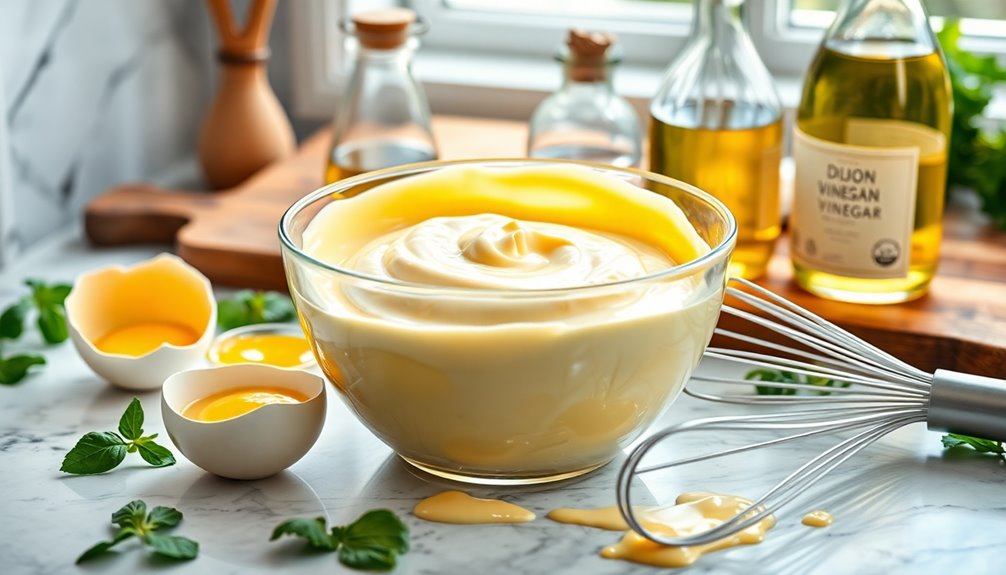You can whip up a tasty homemade mayonnaise in just minutes! Start with one large room-temperature egg, a tablespoon of Dijon mustard, and a tablespoon of vinegar or lemon juice. Gradually whisk in a cup of neutral oil, like olive or vegetable, until the mixture is creamy. Add salt to taste and feel free to customize with herbs or garlic for extra flavor. Make sure all your ingredients are at room temperature for the best emulsification. Store your mayo in an airtight container in the fridge for up to a week. There's more to explore about tricks and variations!
Key Takeaways
- Gather fresh ingredients: 1 large egg, 1 tablespoon Dijon mustard, 1 tablespoon vinegar or lemon juice, 1 cup neutral oil, and salt.
- Whisk the egg yolk with mustard, then slowly drizzle in oil for proper emulsification.
- Incorporate vinegar or lemon juice for added flavor and adjust seasoning with salt to taste.
- Ensure all ingredients are at room temperature for optimal emulsification and consistency.
- Store homemade mayonnaise in an airtight container in the refrigerator for up to one week.
History
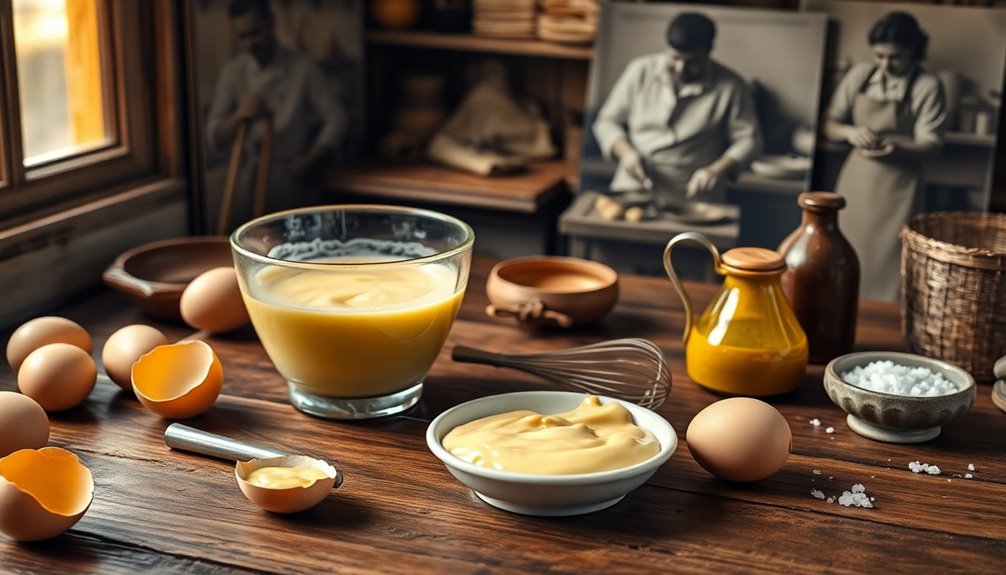
When you plunge into the history of mayonnaise, you'll discover it's a tale that spans centuries and cultures.
This creamy condiment likely originated in the mid-18th century, with its name linked to the city of Mahón in Spain. Some say it was created by a French chef who sought to impress a duke.
As you dig deeper, you'll find variations across Europe, each reflecting local flavors and ingredients. By the 19th century, mayonnaise had become a staple in French cuisine, eventually making its way to America.
Its versatility has allowed it to evolve, inspiring countless adaptations. Today, mayonnaise is more than just a spread; it's an essential ingredient in salads, sandwiches, and dips, celebrated worldwide for its rich texture and flavor.
Recipe
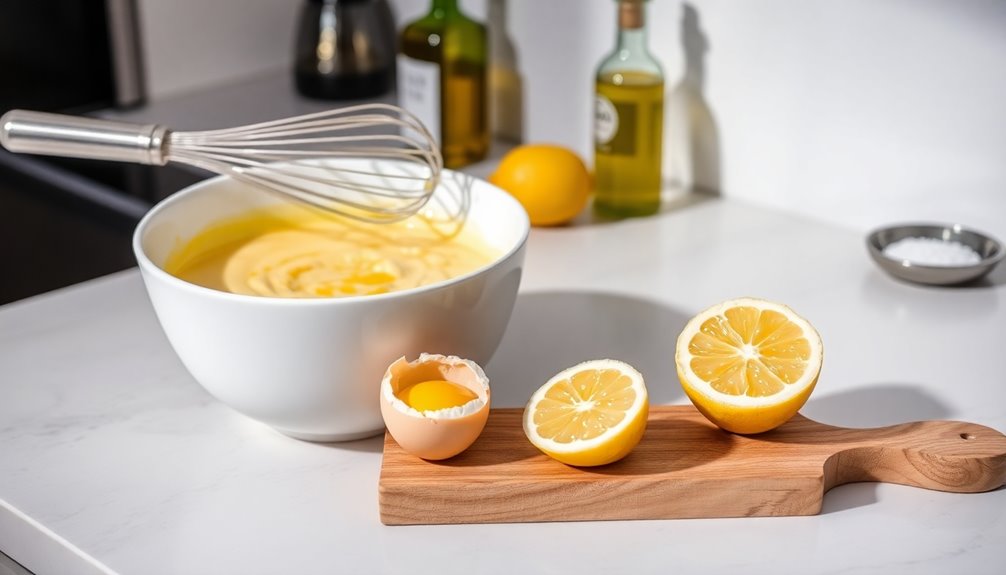
Making homemade mayonnaise is a simple process that yields a rich and creamy condiment perfect for sandwiches, salads, and dips. Unlike store-bought varieties, homemade mayonnaise allows you to customize the flavor and texture to your liking, guaranteeing freshness and quality. With just a few basic ingredients, you can whip up a batch in no time, using either a whisk, blender, or food processor.
To achieve the perfect mayonnaise, it's important to use room temperature ingredients, as this helps in emulsifying the mixture. You can experiment with different oils, such as olive oil or avocado oil, to add unique flavors. Once you master the basic recipe, consider adding herbs, garlic, or spices to create your own signature mayonnaise.
Ingredients:
- 1 large egg (room temperature)
- 1 tablespoon Dijon mustard
- 1 tablespoon white wine vinegar or lemon juice
- 1 cup oil (such as olive oil or vegetable oil)
- Salt to taste
To prepare the mayonnaise, combine the egg, Dijon mustard, and vinegar or lemon juice in a bowl or blender. If using a whisk, beat the mixture thoroughly until fully combined.
Then, while continuously whisking or blending, slowly drizzle in the oil. This gradual addition allows the mixture to emulsify and thicken. Continue until all the oil is incorporated and the mayonnaise reaches your desired consistency. Finally, season with salt to taste.
When making mayonnaise, it's vital to confirm that all ingredients are at room temperature to facilitate proper emulsification. If the mixture doesn't thicken, try adding a teaspoon of warm water and whisking again.
For a thicker consistency, use less oil initially and gradually increase as the mixture thickens. Homemade mayonnaise can be stored in an airtight container in the refrigerator for up to one week. Enjoy experimenting with flavors and have fun with your homemade creation!
Cooking Steps

To make your mayonnaise, you first need to gather fresh ingredients.
You'll start by adding the egg yolk slowly and whisking in the oil gradually.
Finally, you'll incorporate vinegar or lemon juice and season with salt and pepper to taste.
Step 1. Gather Fresh Ingredients
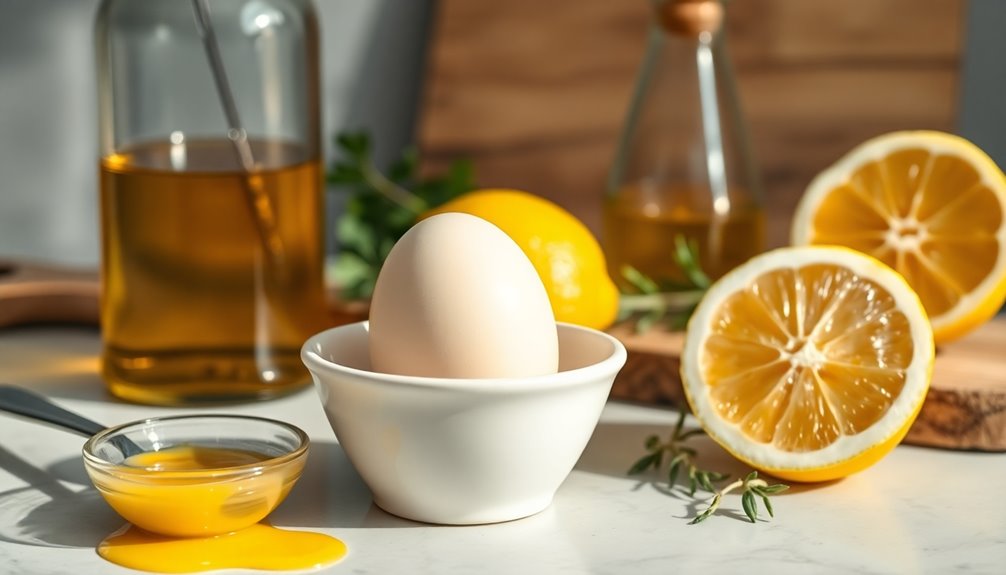
Before you plunge into making your homemade mayonnaise, it's essential to gather the freshest ingredients possible.
Start with high-quality eggs; using organic or free-range eggs makes a noticeable difference in flavor. Next, pick a neutral oil like canola or grapeseed oil, as they blend well without overpowering the taste.
You'll also need a splash of vinegar or lemon juice for that tangy kick, so choose fresh citrus or a quality vinegar like white wine or apple cider. Don't forget salt for seasoning; a fine sea salt works best.
Once you have everything on hand, you're ready to create a creamy, delicious mayonnaise that elevates any dish. Fresh ingredients make all the difference in achieving that perfect texture and taste!
Step 2. Add Egg Yolk Slowly
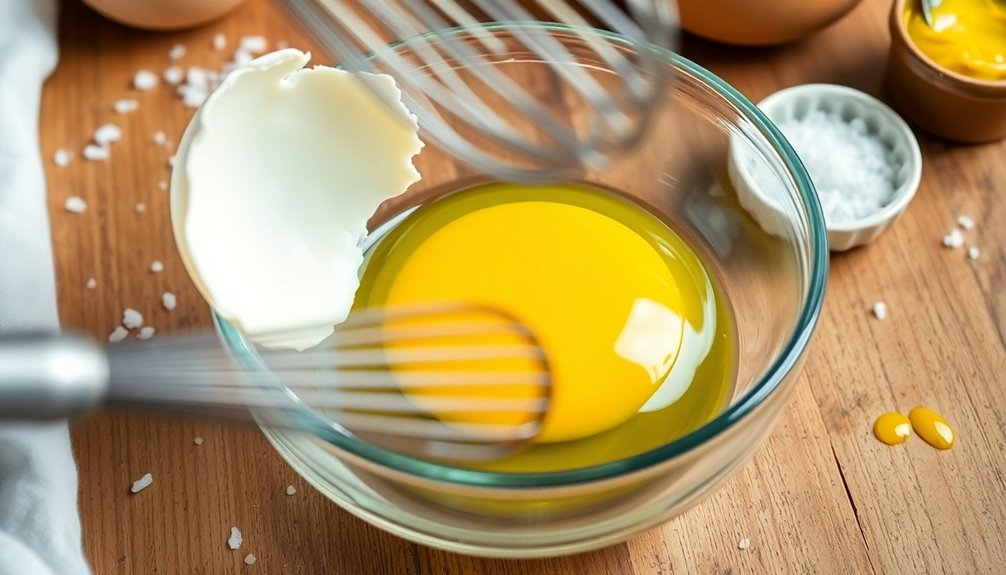
With your fresh ingredients ready, the next step is adding the egg yolk. Crack the egg and separate the yolk from the white, placing the yolk in a mixing bowl.
Make certain your bowl is clean and dry to guarantee proper emulsification. You'll want to beat the yolk gently with a whisk or fork until it's smooth and slightly frothy. This helps create a stable base for your mayonnaise.
It's essential to add the yolk slowly; doing so allows it to emulsify properly with the other ingredients. Take your time and focus on achieving a creamy consistency.
Paying attention to this step will set you up for a successful homemade mayonnaise that's rich and delicious.
Step 3. Whisk in Oil Gradually
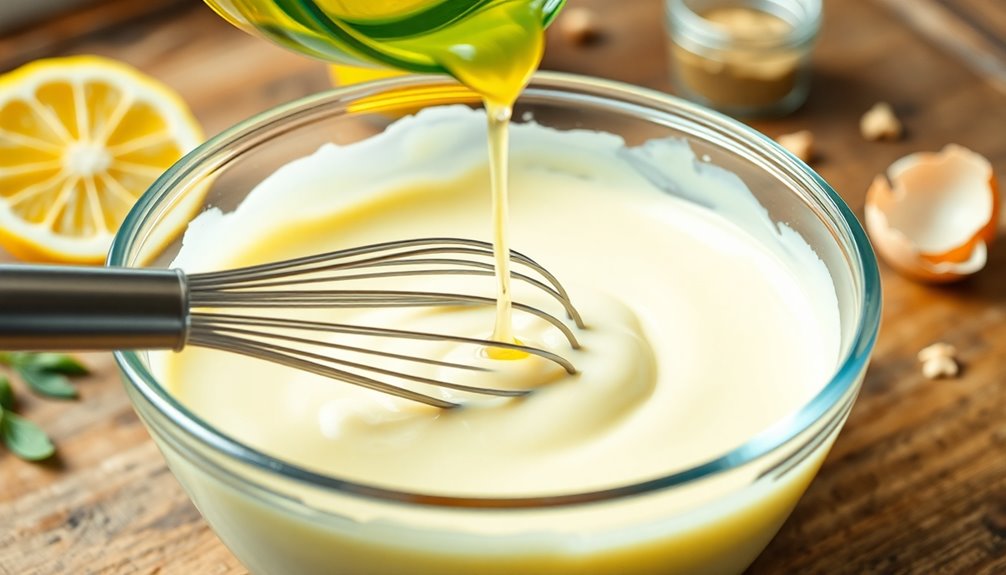
Start whisking in the oil gradually, an essential step that secures your mayonnaise achieves that perfect, creamy texture.
Begin by drizzling in just a few drops of oil while you whisk vigorously. This initial incorporation helps emulsify the mixture, creating a stable base.
As you notice the mayonnaise thickening, you can slowly increase the oil flow to a thin stream. Keep whisking continuously during this process to guarantee the oil blends seamlessly with the egg yolk, creating that luscious consistency.
If at any point it seems too thick, you can add a teaspoon of water to loosen it up.
Step 4. Incorporate Vinegar or Lemon Juice
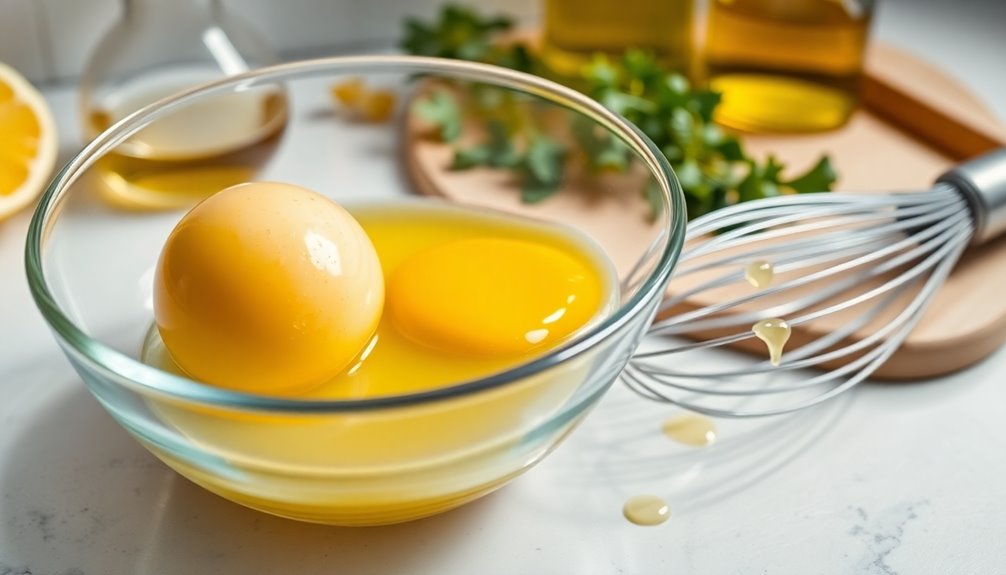
Once your mayonnaise has reached that desired thickness, it's time to elevate its flavor by incorporating vinegar or lemon juice.
Start by choosing your acid—white vinegar, apple cider vinegar, or freshly squeezed lemon juice all work well. Measure about one tablespoon of your chosen ingredient for every cup of mayonnaise.
Now, slowly whisk the vinegar or lemon juice into the mayonnaise. This won't only enhance the taste but also help stabilize the emulsion.
Keep whisking until the acid is fully integrated and the mixture is smooth. Taste your mayonnaise to see if you want to add a bit more tang.
Step 5. Season With Salt and Pepper
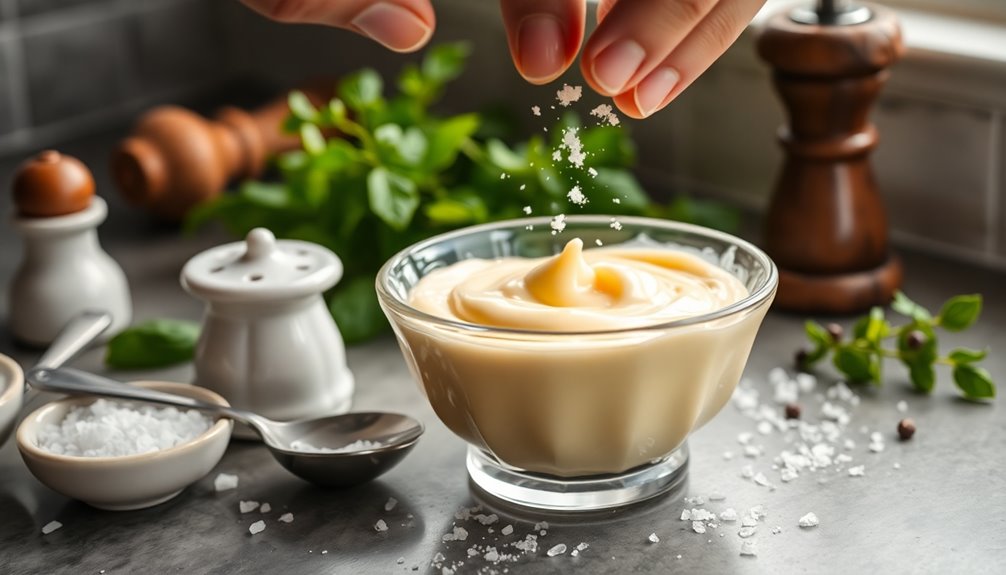
As you mix in the vinegar or lemon juice, don't forget to season your mayonnaise with salt and pepper for that extra depth of flavor.
Start with a pinch of salt, tasting as you go. It's all about balance—too much can overpower your mayo.
If you're using fresh ground pepper, add a few cracks to enhance the taste without overwhelming it.
Mix everything thoroughly, ensuring the salt and pepper are evenly distributed throughout.
Keep tasting until you achieve the perfect flavor profile that suits your palate.
Remember, you can always add more, but you can't take it out once it's in!
Once you're satisfied, your homemade mayonnaise is ready to elevate any dish. Enjoy!
Final Thoughts
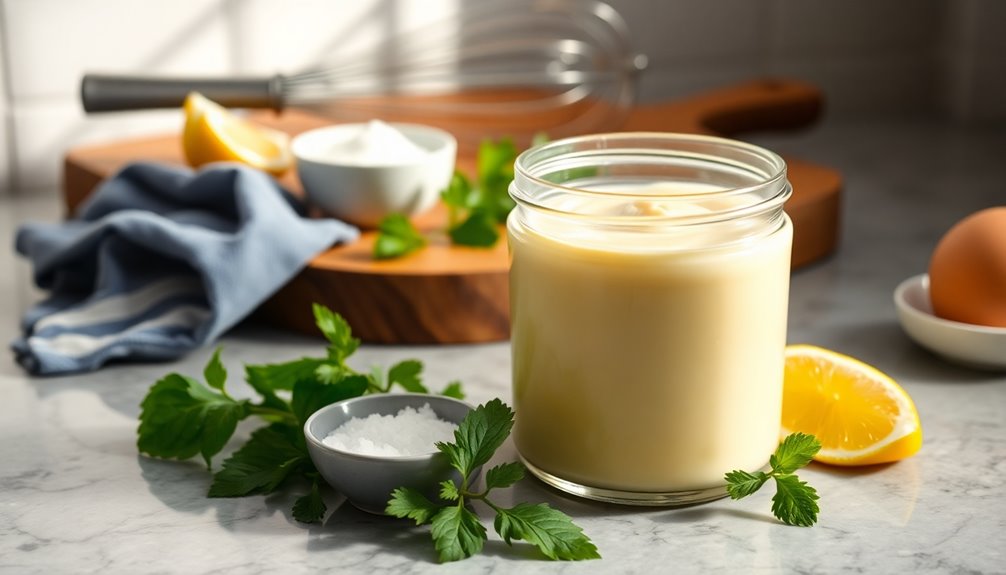
While making mayonnaise may seem intimidating at first, you'll quickly find that it's a simple and rewarding process.
Once you've mastered the basics, you can experiment with various flavors and ingredients to create a unique condiment tailored to your taste.
Don't be afraid to adjust the seasoning or add a splash of lemon juice for brightness.
Frequently Asked Questions
Can I Use Vegan Substitutes for Mayonnaise?
Absolutely, you can use vegan substitutes for mayonnaise! There are plenty of options available, like store-bought vegan mayo made from ingredients like aquafaba or soy.
You can also whip up your own using blended silken tofu, lemon juice, and a bit of mustard. These alternatives mimic the creamy texture and tanginess you're after, so you won't miss the traditional stuff.
Experiment with flavors to find what you love best!
How Long Does Homemade Mayonnaise Last in the Fridge?
Homemade mayonnaise typically lasts about four to seven days in the fridge.
To guarantee it stays fresh, store it in an airtight container and keep it at the back of the fridge, where temperatures are more stable.
Always check for any off smells or changes in texture before using it. If you notice anything unusual, it's best to toss it out.
Enjoy your homemade creation while it's still at its best!
What Can I Do if My Mayonnaise Is Too Thin?
If your mixture's too thin, don't worry! You can fix it.
Start by adding a little more oil, drizzling it in slowly while whisking vigorously until it thickens. Alternatively, you could incorporate an egg yolk or a bit of mustard to help stabilize the emulsion.
Just remember, patience is key. Keep mixing until you achieve that creamy texture you're aiming for, and you'll have a delicious mayonnaise in no time!
Is It Safe to Use Raw Eggs in Mayonnaise?
Using raw eggs can pose some health risks, primarily due to the potential for salmonella.
If you're concerned about safety, you might want to use pasteurized eggs instead. They provide a similar texture and flavor without the risk.
Also, consider making mayonnaise with alternatives like aquafaba or using store-bought versions that don't contain raw eggs.
Always prioritize safety in your cooking choices to guarantee you and your guests stay healthy.
Can I Flavor Mayonnaise With Herbs or Spices?
Absolutely, you can flavor mayonnaise with herbs or spices!
Just mix in your favorite ingredients to create a unique twist. Fresh herbs like basil, dill, or cilantro work great, and spices such as garlic powder, paprika, or cayenne pepper add a nice kick.
Start with small amounts, taste as you go, and adjust to your liking. This way, you'll enjoy a personalized spread that elevates your sandwiches and dips!
